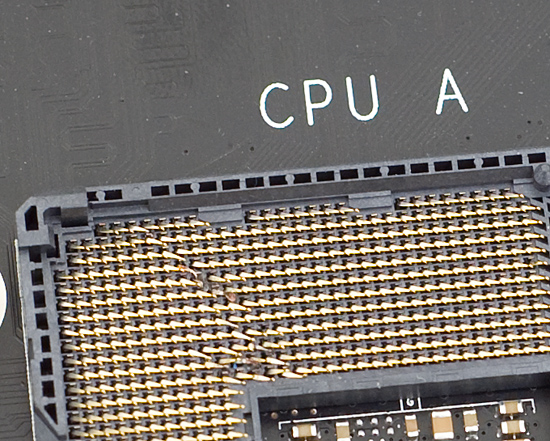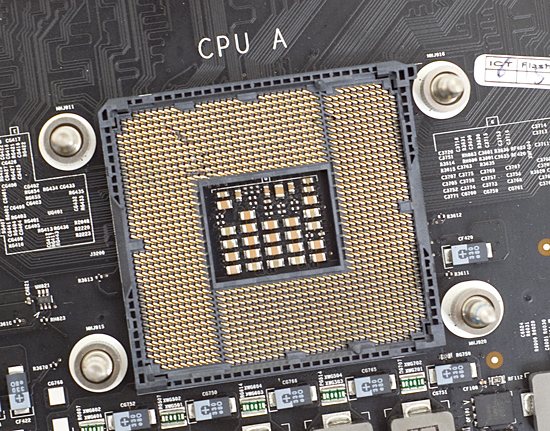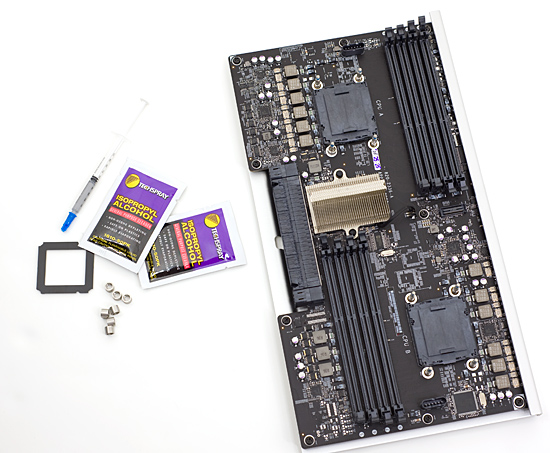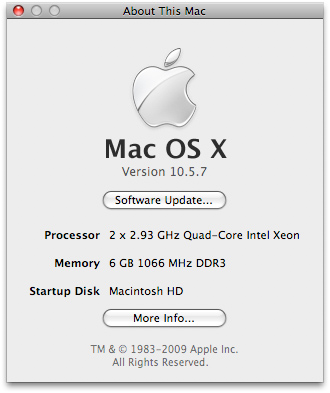Upgrading and Analyzing Apple's Nehalem Mac Pro
by Anand Lal Shimpi on July 13, 2009 5:00 PM EST- Posted in
- Mac
The two heatsinks on the Mac Pro aren’t interchangeable, so keep track of which one came from where and don’t try to force their installation if they don’t fit properly.

After we completed the swap, we powered the machine on and were met with the worst sound: fans that didn’t spin down. The Mac Pro refused to POST and forcing it to turn off revealed a CPU A Temperature Overheat warning LED on the motherboard.
Removing the CPU_A heatsink revealed the problem:

uh-oh
CPU_B was fine, but CPU_A was far from it. While there are no pins to bend/break on these LGA CPUs, if anything goes wrong the socket is toast. In this case, both the socket and CPU were beyond saving.
To date I’m not sure what went wrong, but I have two theories. Unlike desktop Nehalem motherboards, there is no clamp that holds the CPU in place. There’s a chance that during the heatsink installation that the CPU moved slightly and shorted as soon as it got power.

The other theory is that I somehow over tightened the heatsink on CPU_A. Remember, the chips I used had heat spreaders, the ones they were replacing did not. The added thickness of the heat spreader could have helped push the CPU too hard against the pins in the socket, causing some of them to move out of place.
Regardless of the how, what remained was that I now had a dead Xeon and a dead Mac Pro processor board on my hands. The CPU I could always replace from my stash, but I don’t keep many Nehalem Mac Pro processor boards in my parts closet. This would require a trip to the Apple store.
And if you’ve ever walked into an Apple store holding a Nehalem Mac Pro processor board, you’ll get some looks.
Thankfully, the folks at the Crabtree Valley Mall Apple Store in Raleigh, NC are AnandTech readers and quickly understood what had happened. They ordered the replacement part and I waited. If you’re curious, it’ll cost a bit under $400 to replace the processor board in an 8-core Mac Pro provided you allow Apple to keep your dead board.

The new board and its accessories
It’s been years since I’ve killed a processor and this would be my first LGA socket death, so I was admittedly nervous once I had the new board in hand. I went in and tried to replace the chips again, this time under tightening all of the hex screws on the heatsinks just to be safe.
I mounted and dismounted each heatsink three times before committing to the install. Nervously, I hit the power button.
I had good news and bad news.
The bad news, the fans were spinning at full speed. The good news? The upgrade worked. Initially I didn’t tighten the heatsinks enough so some of the memory channels weren’t working, but a couple more spins of the hex key and I was in business.
The fans spinning at full speed were caused by the thermal sensor on one of the heatsinks being dead. It looks like it died when the first CPU shorted out. The folks at the Apple store had to order me a replacement heatsink as well.
After the smoke cleared and my embarrassment subsided, I had an upgraded Nehalem Mac Pro.

I started with a pair of 2.26GHz Xeon E5520s and ended up with a pair of 2.93GHz Xeon X5570s.
Gaining access to the processors is far easier than the previous generation Mac Pro, but you have to exhibit more care in physically replacing them. The fact that the CPUs I used had integrated heat spreaders hasn’t caused any problems either. Temperatures are well within reasonable limits, the fans are just as quiet as before and Turbo mode still works.










58 Comments
View All Comments
analog1 - Thursday, July 16, 2009 - link
Why not run the same benchmarks, like Premier pro cs 4 and Photoshop on a Core i7 PC?I think the results will surprise a low of people. I have sen comparisons done with Protools - a highly threaded proffessional DAW ( Digital Audio Workstation) 8 core nehalem Mac Pro (16 thread) vs an OCed i7 920 (3.6 ghz) and the 920 beat the mac pro by roughly 20%. This is probably due to much higher clock speeds, much higher memmory speeds and bandwidth, and much more efficient OS! (yes Windows XP). All this for about $2000 less.
If display cards had anything to do with this test the price/performance difference would be even higher. This is testing audio processing only.
I think if Anand could take the time and bench an OCed or stock i7 920 vs 8 core mac pro on the apps used with the same content we will all be finally able to throw the mac 'CREATIVITY' marketing slogan out the window for good.
I use macs every other day and am writing this on a mac (dual G5, but still). I also use PCs on a daily basis. all for work no play. I have been doing this for years, and honestly I don't understand why people like macs. they are SIMPLER not BETTER.
OSX has nice animation, and the iPhone is cool. Bravo Apple. Now can we please get a REAL bench for these apps PC vs Mac so we can all go to sleep knowing we actually do have the best system for $1000, even if it was designed by Antec+Seasonic+Corsair+Termalright+Gigabyte and so on... (and not buy Apple)
tstm - Wednesday, July 15, 2009 - link
What this article deserves, is a slap to Apple because of their memory configurations.The low end Mac Pro comes with four (4) memory slots. That's utterly ridiculous, considering that Nehalem supports triple channel memory. Adding 8GB (4x2GB) of memory will bring the memory bandwidth down somewhat, which is unacceptable for a $2500 machine.
The 8 core version, on the other hand, comes with 8 slots, again not a multiple of 3. With DDR3 SDRAM 4GB sticks being so ridiculously expensive, this makes any larger memory configs for the Mac Pro extremely expensive.
There's one more gripe: The server CPUs Apple uses could use RDIMM or UDIMM memory, which is _a LOT_ cheaper than normal DDR3 SDRAM mostly because it's being used in server configurations where it's not unheard of to have 192GB of ram in a machine, no one wants to pay gazillions for the 8GB DDR3 SDRAM sticks that would require.
Buying a server board with 18 RDIMM/UDIMM memory slots for building a similar workstation as the Mac Pro would be an insanely much better solution for anything that requires memory to operate (running multiple test VMs for instance). I think it's pretty sad that apple is not even trying to cater professionals with this "Mac Pro" toy they've built. I really would like to use an apple computer, but these drawbacks made me use a Hackintosh, which has its own drawbacks.. but for workstation use none are so bad when you compare it to the Mac Pro.
fmaste - Tuesday, July 14, 2009 - link
So, this is a good computer after changing the CPU and buying a second video card. How could someone say that this is OK? I don't think that Apple notebooks are expensive, you really get a premium notebook with all premium components, but this seems very overpriced.I like Apple and OSX a lot, but the case and interior design don't cost that much, you can build your own computer for much less, and with one of the awesome cases reviewed here at anandtech.
Also, what about GPU performance and comparison?
Third party GPUs? How? Expansion slot available?
Power, Noise, heat?
What about Boot Camp?
Type of memory?
And I would really appreciate a price and performance comparison with other workstations and what you can build for that money.
Tutor - Thursday, July 16, 2009 - link
This is my dream machine at post #10. I call it MyHackedUpMac.Tutor - Thursday, July 16, 2009 - link
http://forums.macrumors.com/showthread.php?t=71393...">http://forums.macrumors.com/showthread.php?t=71393...BoboGO - Tuesday, July 14, 2009 - link
Two 3.2GHz Quad-Core Intel Xeon "Nehalem" processors!12GB (6 x 2GB) DDR3 1333 (PC3 10600) memory
NVIDIA GeForce GTX 285 with 2GB GDDR3 memory
8X Blu-Ray Writer
250GB Vertex SATA II MLC Internal Solid state disk (SSD)
1TB SATA 3.0Gb/s hard drive
22X DVD/CD double-layer writer with LightScribe support
X-Fi Titanium Fatal1ty Champion Series 7.1 Channels PCI-Express Sound Card
Thermaltake Xaser VI Black Aluminum Computer Case
Sorry, no monitor included.
Ships: 3 days
Total Cost: $5833.00
vailr - Tuesday, July 14, 2009 - link
Re:"I couldn’t wait any longer and I ended up building a Hackintosh based on Intel’s Core i7. Literally a day after I got it up and running, Apple announced the new Nehalem-EP based Mac Pro."
More details, please.
List of parts used & cost, the method used for installing OSX, & a "bang for buck" comparison with Apple's equivalent machine.
TIA
erple2 - Wednesday, July 15, 2009 - link
That's a good question. Also, how much time did you spend getting the Hackintosh up and running?And for the final question, how much do you believe your time to be worth? I know how much I am paid per hour at my job. It doesn't take that long of hassling with a Hackintosh to make it worth my while to just buy the Mac instead. Include time spent when I go to update the OS and have to research which updates will work with my particular Hackintosh, plus those times that I accidentally do an update that I didn't fully research and hosed my setup. Oh, and make sure that I factor in some time for when my soundcard just didn't quite work right after a reboot...
Ultimately, it boils down to the triplet: Time, Money, Productivity - pick two.
Baked - Tuesday, July 14, 2009 - link
Wait, people actually upgrade their Mac? I thought they just buy a new one when it gets real slow. At least that's what happens at the places I worked at. Buy a brand new Mac, use it for a few years, buy a new one and send the old one to surplus. We do buy memory from micron instead of doing it through Apple though.xz4gb8 - Tuesday, July 14, 2009 - link
You said, "Between the high cost of the adapter and the high likelihood of problems, I’d suggest simply getting another video card if you want to have multiple 30” displays connected to your Mac Pro. Apple sells the GeForce GT 120 for $150 as an upgrade option, and at least with it each 30” display will be driven by its own frame buffer, which should make for smoother Exposé and Dashboard operation."If you allow non-Apple displays, many higher-end displays have DisplayPort connectors - see the Dell 3008WFP, for example. A mini-DP to DP cable is under $20 including shipping.
The mini-DP to DVI adapter is too clunky and tends to unplug itself. The mini-DP to HDMI adapter is under $20 and is slightly less clunky. Neither are as elegant as the mini-DP to DP cable.
I make no claims for the Video card performance.